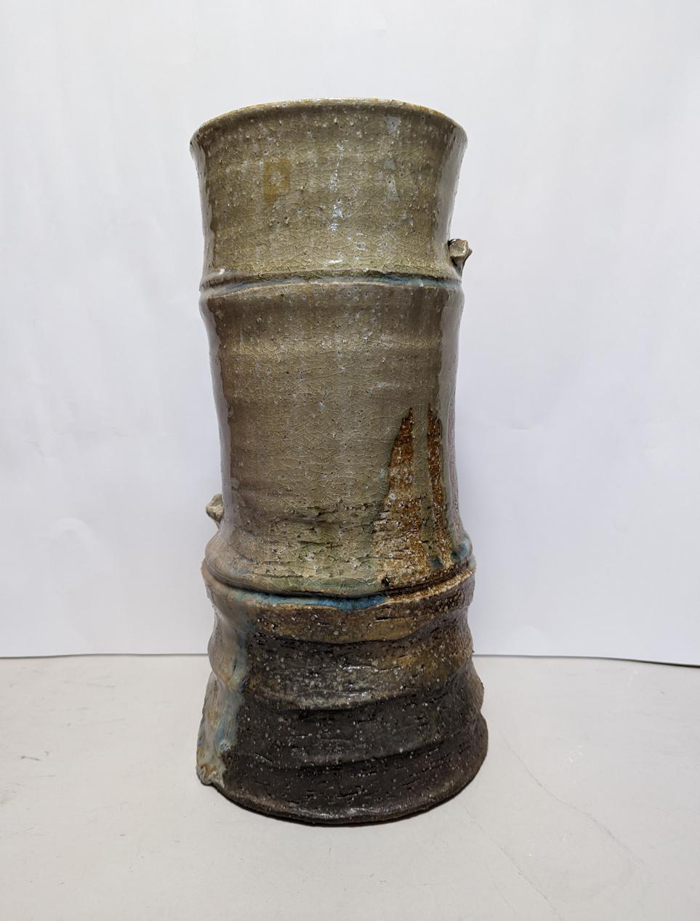
Hagi Yohen (Kiln-Transmutation) Bamboo Tube Flower Vase
Diameter: 18 cm
Height: 36 cm
At the firebox (or stoking port) of the climbing kiln (noborigama), the flame and smoke from the firewood repeatedly cause oxidation and reduction, resulting in a color change to a greenish yellow.
The patterns, which are unintentional and created by nature, possess a profound and subtle beauty (or Yugen).
Hagi Teacup
touching warmth, simpleness.
The more natural, the more telling its character.
Difference of shrinkage factor between slip and glaze makes such crazes.
Aiming them with rough clay called gOni Hagih.
Hagi clay is from mountains and fired with low temperature.
Like clay pots, it has smoothness, good heat-retaining and soft feel when touching.
Furthermore, The more you use it, the more full-of-flavor.
distorted neck
The neck of the vase was distorted by thrown firewood when it was made.
At tea ceremony's way of thinking, it is also indivisuality.
Which finding beauty and making use of such vase or not depends on user's ability.
WABI Philosophy
"Hagi-Yaki" was a Proprietary pottery of Mouri family(Japanese feudal lord) only for Matcha tea ceremonies (chanoyu/sado/chado).
Tea ceremony is Zen and Philosophy.
Also instruments themselves must have philosophy.
They should be innocent and unconscious.
Not surface-dressed beauty, but one from inside.
Then WABI beauty felt by spirit borns.
It was reached by Sen-no Rikyu(1522-1591) and other Tea ceremony giants.
It is the main concept of beauty in Japan and still living today.
Tea ceremony itself had changed (for superficial), however we can still find beauty with only one cheap handmade matcha bowl.
We can understand only when we touch and use it.
Beauty of WABI is feeling simplicity and innocent.
Encounter and Deep Emotion
A Thing begins with encounter and deep emotion.
That may be sometimes a thing, sometimes a people.
Only deep emotion can be a revolution of spirit, or exploration mind.
For me, encounter with Old Karatsu "Mizusashi"(a water picher on Japanese tea ceremony) was that.
My view for pottery was fundamentally changed.
Is this made by a human!?
Pomp and circumstance: Breathing for several hundred years.
The thing I was more surprised was when I put the water into the Mizusashi.
Because it had not been used for several hudred years, it soaked water with roar.
It appeared to be a human being.
Still I can't forget the sound.
First, like a growl from the bottom of the stomach.
Then gradually became calm.
Drops of surface looked like Tears of joy.
I felt the spirit of the pottery maker and was very moved.
Pottery, especially made of soil not of ceramics, always breaths and live the times.
We have to succeed the beauty of pottery and the things which great forefathers accomplished, to the next generation.
One day, Dialogue with a student
"Though Japanese Potteries are great, People can live without them..."
I said to a student.
He answered,
"No, it needs rejoice, comfort and purpose for life"
I got it. If there is no emotion or joy, it becomes aridity, same as machines.
Sometimes only tiny things of every day make us happy.
I am happy when I give warmth or relaxation to someone with potteries.
I will be much happier when they are interested in its culture.
It will be connected to next generations.
I have to look for and provide such potteries.
29.5.2015
Touch with the palm of the hand
We can feel at once when we touch.
It is difficult to encounter the ones having warmth and calmness.
Clay potteries and Kaolin ones (ceramics) are markedly different.
Hagi-yaki is former.
Especially Hagi-yaki has been used specially for tea ceremonies, the difference has big influence.
We can only feel warmth and calmness from potteries only when they are made with a kind of unconciousness.
